abdomen - The ventral part of the body between the thorax and the pelvis.
altricial - Mammals that are born in relatively undeveloped condition (eyes closed and with minimal fur) and require prolonged parental care—as opposed to precocial.
alveolar - Of or pertaining to an alveolus (plural, alveoli), a small cavity or pit, as a socket for a tooth. Alveolar length of a tooth-row therefore denotes the length of the row of the teeth, taken from the posteriormost place where the back tooth emerges from the bone to the anteriormost point where the front tooth in the row emerges from the bone—the overall length of the bony sockets for the row of teeth.
angular process - The projection at the posterior, ventral end of the mammalian dentary. See "dentary".
annulation - A circular or ringlike formation, as of the dermal scales on the tail of a mammal where one ring of scales that extends entirely around the tail is succeeded, posteriorly, by other rings.
arboreal - Inhabiting or frequenting trees—contrasted with fossorial, aquatic, and cursorial.
auditory bulla (plural, auditory bullae) - A hollow, bony prominence of rounded form (in most mammals formed by the tympanic bone) partly enclosing structures of the middle and inner ear.
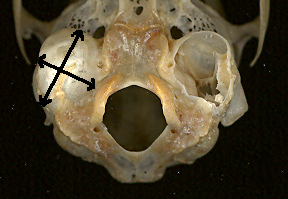
Ventral view of posterior skull of Nuttall's Cottontail Sylvilagus nuttallii, showing an auditory bulla (left); the wall of the right bulla has been broken, revealing the inside of the bulla.
basal length - Distance on skull from the anteriormost inferior border of the foramen magnum to a line connecting the anteriormost parts of the premaxillary bones.
basilar length - Distance on skull from the anteriormost inferior border of the foramen magnum to a line connecting the posteriormost margins of the alveoli of the first upper incisors.
bead - A salient, rounded cordlike projecting ridge of bone, as in certain rodents where the superior border of the orbit is beaded.
braincase - The part of the skull enclosing the brain.
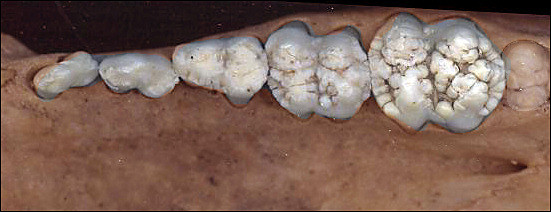 bunodont dentition - Referring to the cusp type of molars
and/or premolars: cusps are low and rounded. The figure shows upper cheekteeth of a young domestic pig; some bunodont dentition, such as human teeth, are simpler; others are more complex.
bunodont dentition - Referring to the cusp type of molars
and/or premolars: cusps are low and rounded. The figure shows upper cheekteeth of a young domestic pig; some bunodont dentition, such as human teeth, are simpler; others are more complex.
calcar - In bats a process connected with the calcaneum (heel bone) and extending into the uropatagium near its edge, helping to support the uropatagium
(the fold of skin that extends between the leg and tail). A keeled calcar is one with a definite flap of membrane posterior to the calcar extending beyond the general margin of the uropatagium.
cancellous - Having a spongy or porous structure.
canine - Of, pertaining to, or designating the tooth next to the incisors in mammals. Of or pertaining to dogs or to the family Canidae.
carnivore - An animal that preys on other animals; an animal that eats the flesh of other animals; especially any mammal of the Order Carnivora.
cheek-teeth - Teeth behind the canines.
conch (plural, conchs) - The external ear of a mammal; sometimes the spelling is concha (plural, conchae); the origin of both spellings is conch or konch, originally a bivalve shell of a marine mollusk.
condylar (condyloid, articular) process. On a mandible, the process ending in the articular condyle. See "dentary".
condylobasal length - Least distance on skull from a line connecting the posteriormost projections of the exoccipital condyles to a line connecting the anteriormost projections of the premaxillary bones.
coronoid process - The upward projecting process of the posterior part of the mandible, giving attachment on its outward side to the masseter muscle and on its inner side to the temporal muscle. See "dentary".
dental formula (plural, formulae) - A brief method for expressing the number and kind of teeth of mammals. The abbreviations i. (incisor), c. (canine), p. or pm. (premolar), and m. (molar) indicate the kinds in the permanent dentition, and the number in each jaw is written like a fraction, the figures above the horizontal line showing the number in the upper jaw, and those below, the number in the lower jaw. For deciduous teeth, the abbreviation is preceded by "d".
dentary - A tooth-bearing bone of the lower jaw. In mammals, it is the only bone on a side; in all other vertebrates, it is accompanied by other bones.
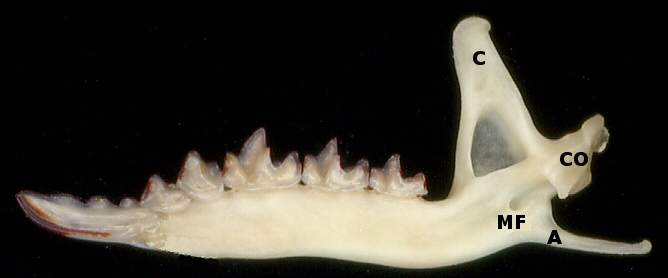
Lingual view of the right dentary of a Montane Shrew (Sorex monticolus). "C" indicates the coronoid process; "CO" the condyloid (articular) process; "A" the angular process; and "MF" the mandibular foramen
dentine - A calcareous material, harder and denser than bone, which composes the principal mass of a tooth.
dentition - The teeth, considered collectively, of an animal.
deuterocone - One of the cusps of a premolar tooth of a mammal corresponding in position (anteromedial) to the protocone of a true molar.
diastema—A vacant place or gap between teeth in a jaw.
 Ventral view of anterior skull of a Pallid Bat, showing the diastema between the
incisors at the front of the palate.
Ventral view of anterior skull of a Pallid Bat, showing the diastema between the
incisors at the front of the palate.
digitigrade—Walking on the toes and distal ends of the metapodials.
dilambdodont - Molars with a W-shaped outer ridge.
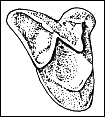 Drawing of a dilambdodont molar.
Drawing of a dilambdodont molar.
diurnal - Active by day—, as opposed to nocturnal.
enamel - Of teeth, the hardest substance of the mammalian body and forming a thin layer that caps or partly covers a tooth.
feces - Intestinal excrement, droppings, scat.
femur (plural, femora) - The proximal bone of the hind limb.
foramen magnum - The large opening in the back of a skull through which the spinal cord passes to become the medulla oblongata of the brain.
forearm - The part of the forelimb between the elbow and wrist.
fossorial - Fitted for digging.
frontal - Pertaining to or designating the bone (paired) immediately in front of the parietal bone and behind the nasal.
gestation period - The period of carrying young in the uterus, as applied to placental mammals; the period of pregnancy.
guard hairs - The stiffer, longer hairs that grow up through the limber, shorter hairs (fur) of a mammal's pelage.
habitat - The kind of environment in which a species of organism is normally found.
hamular process of pterygoid - A hooklike process on the pterygoid bone.
hibernation - Torpidity, especially in winter entered into by some kinds of mammals; the bodily temperature approximates that of the surroundings; the rate of respiration and the heart beat are much slower than in a non-hibernating mammal.
horizontal ramus - In a lower jaw, the ramus bearing the teeth, and anterior to the vertical ramus.
incisive foramen - The anterior palatine foramen, which are paired, are in the bony roof of the anterior part of the cavity of the mouth at the juncture of the premaxillary bones and maxillary bones; they transmit nasal branches of palatine arteries and nasopalatine ducts of Jacobson.
incisor - Pertaining to or designating one of the teeth in front of the canine tooth; those in the upper jaw invariably are in the premaxillary bone.
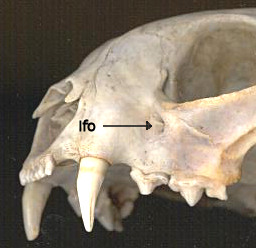
infraorbital foramen or canal - A hole or passageway (canal) through the maxillary bone from the face to the orbit. See the image of the bobcat skull; the arrow marked "ifo" points to the infraorbital foramen.
inguinal - Pertaining to or in the region of the groin.
insectivorous - Eating insects; preying or feeding on insects.
interfemoral membrane - In a bat, the fold of skin stretching from hind legs to tail. The uropatagium.
interorbital constriction - The least distance across the top of the skull between the orbits (eye sockets).
interorbital region - The region between the eye sockets; the region of the skull between the rostrum and the braincase.
interparietal - Pertaining to or designating the bone (rarely paired) immediately in front of the supraoccipital bone and between the two parietal bones.
litter - The two or more young brought forth at one birth by a female mammal.
loph - A combining form used as the terminal part of certain words and denoting the ridges (or areas) composed of several cusps and styles on the occlusal face of a tooth, as protoloph.
M2 - Designation of the second true molar in the upper jaw of a mammal.
mammae (singular, mamma) - The glandular organs for secreting milk.
mastoid - Designating or pertaining to the mastoid bone (paired) or its process. This bone is bounded by the squamosal bone, the exoccipital bone, and the tympanic bone.
maxillary breadth - Width of skull from some designated place on the lateral face of the right maxillary bone (maxilla) to the corresponding place on the left maxillary bone; in shrews, across the ends of the zygomatic processes of the two maxillary bones.
maxillary toothrow - The row of teeth in one maxillary bone; in most mammals all the premolars and molars on one side of the upper jaw.
metabolic water - Water formed as an end product of cellular combustion of foodstuffs in an animal's body.
metacarpal - Of or pertaining to a metacarpal bone. A bone of the hand or forefoot between the wrist and fingers; when all the digits are present ,there are five more or less elongated metacarpal bones, one at the base of each digit.
molar - Of or pertaining to a molar tooth. One of the teeth behind the premolar teeth; a molar tooth is not preceded in embryological development by a deciduous (milk) tooth.
molt (moult) - In a mammal, the act or process of shedding or casting off the hair, or outer layer of skin or horns; most mammals shed the hair once, twice, or three times annually. The cast off covering (obsolete). As a verb: to be shed (intransitive) or to shed (transitive).
nasal - Of or pertaining to the nose, as a nasal bone (paired) on the dorsal surface of the skull at its anterior end. A nasal bone.
nocturnal - Active by night (opposed to diurnal).
occipitonasal length - Least distance between two vertical lines, one touching the posteriormost part of the skull above the foramen magnum (opening for the spinal cord) and the other touching the anteriormost part of the nasal bones or a nasal bone.
occlusal - Of or pertaining to the grinding or biting (occluding) surface of a tooth.
opposable - Capable of being placed opposite something else; said of the first toe of an opossum in the sense that it can be placed opposite each of the other toes on that same foot.
orbit - The cavity in the skull in which the eye and its appendages are situated; the eye socket.
osseous - Composed of, or resembling, bone; bony. Osseous tissue is bony tissue.
overhairs - The longer hairs of the pelage of a mammal that project above the fur (shorter hairs).
P3 - Designation of the third (next to last) premolar in the upper jaw of a mammal. Capital letters designate teeth in the upper jaw and lowercase letters designate teeth in the lower jaw.
palatal - Of or pertaining to the palate (as generally used, the bony roof of the mouth made up of two palatine bones, two maxillary bones, and two premaxillary bones).
palate - The roof of the mouth, consisting of the structures that separate the mouth from the nasal cavity. The bony palate is composed of the following bones: premaxillae, maxillae, and palatines.
parietal - Pertaining to or designating the parietal bone (paired) roofing the braincase. This bone is behind the frontal bone and in front of the occipital bones.
pectoral - pertaining to, or situated or occurring in or on, the chest.
pencil - Tuft of fur or hair, as a black pencil on the end of the tail of a mammal.
penicillate - Having a pencil, or tuft of longer hair (see above).
phalanx (plural, phalanges) - A bone, in a finger, distal to the metacarpus or a bone, in a toe, distal to the metatarsus.
pinna (plural, pinnae) - The projecting part of an ear.
plantigrade - Walking on the entire sole of the foot, as in humans and bears.
postauricular - Situated behind the auricle (pinna) of the ear, as a postauricular patch (ordinarily referring to a patch of fur differing in color from surrounding fur).
postorbital - Situated behind the eye, as postorbital process of the frontal bone or postorbital process of the jugal bone.
premaxillary - Of or referring to the premaxilla, a bone (paired), in the mammalian skull bearing the incisor teeth of the upper jaw; the premaxilla is situated in front of the maxilla.
premolar - Designating or pertaining to one of the teeth (a maximum of 4 on each side of upper jaw and lower jaw of placental mammals, or 16 in all) in front of the true molars. When canine teeth are present, premolars are behind these teeth; premolars are preceded by deciduous teeth, and in the upper jaw are confined to the maxillary bone.
proximal - Being nearer to the midline of the body than the referred structure. Thus the wrist is proximal to the hand, the forearm is proximal to the wrist, the elbow is proximal to the forearm, etc. The opposite of distal.
reentrant angle - An infold of the enamel layer on the side, front, or back of a cheek-tooth, as in a molar of a muskrat or wood rat.
rostrum - Of a mammalian skull, the part projecting in front of the orbits.
rut - The breeding period, as in deer.
sagittal crest - The ridge of bone at the juncture of the two parietal bones resulting from the coalescence of the temporal ridges; in old individuals of many species of mammals, the crest extends from the middle of the lambdoidal crest anteriorly onto the frontal bones and divides there into two temporal ridges, each of which extends anterolaterally on the posterior edge of the postorbital process of the frontal bone.
saliva - The fluid secreted by the glands discharging into the mouth.
subauricular spot - A spot, patch of hair, distinctively colored immediately below the ear.
supraorbital process of frontal - The process of the frontal bone on the top rim of the orbit, as in a rabbit.
tarsus - The ankle.
taxon (plural: taxa) - Any group of organisms formally named under the rules of taxonomic nomenclature. Thus Homo sapiens is a taxon that happens to be at the species level. Animalia also is a taxon (at the kingdom level, of course). This differs from rank, which refers to a level of the taxonomic hierarchy (such as genus, order, phylum).
temporal ridge (paired) - A curved, raised line on the side of the braincase marking the upper limit of attachment of the fascia of the temporal muscle. The temporal ridge is prominent on the parietal bone, frequently extends forward onto the frontal bone, and in some kinds of mammals extends backward onto the interparietal bone. When present, the sagittal crest is formed by the coalescence of the two temporal ridges.
terrestrial - Inhabiting the land, rather than the water, trees, or air.
tibia (plural, tibiae) - The inner and usually larger of the two bones of the hind limb (leg) between the knee and the ankle.
torpid - Having lost most of the power of exertion; dormant. A ground squirrel is torpid when it is hibernating.
tricolor - Having three colors. Said of hair on back of a mammal when the hair has three bands, each of a different color.
type locality - The place where a type specimen (holotype) was obtained.
underfur - The short hair of a mammal; in temperate and boreal climates, the underfur ordinarily is denser, made up of more hairs, than the longer and coarser overhair.
underparts - The underneath (ventral) side of a mammal (not the back or sides), as of a woods mouse with white underparts.
unicuspid - A tooth with a single cusp. Usually applied to a set of teeth of shrews, but may be used for any such tooth, such as a canine
tooth.
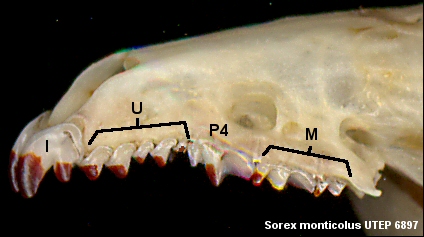
Lateral view of anterior skull of the Montane Shrew (Sorex monticolus) showing unicuspids. I=incisor; U=unicuspid series; P=premolar; M=molar series.
upper parts - The top (dorsal) surface and all of the sides (not the belly, chest, or throat), as of a woods mouse with reddish-brown upper parts.
uropatagium - The interfemoral membrane of a bat; that is to say, the fold of skin that stretches from the hind legs to the tail.
zygomatic breadth - Greatest distance across zygomatic arches of the cranium at right angles to the long axis of skull.
zalambdodont- Molars having a lateral, V-shaped ridge.
Adapted in part from Feldhamer et al. (1999) and Hall (1981)
Last Update: 2 Nov 2007